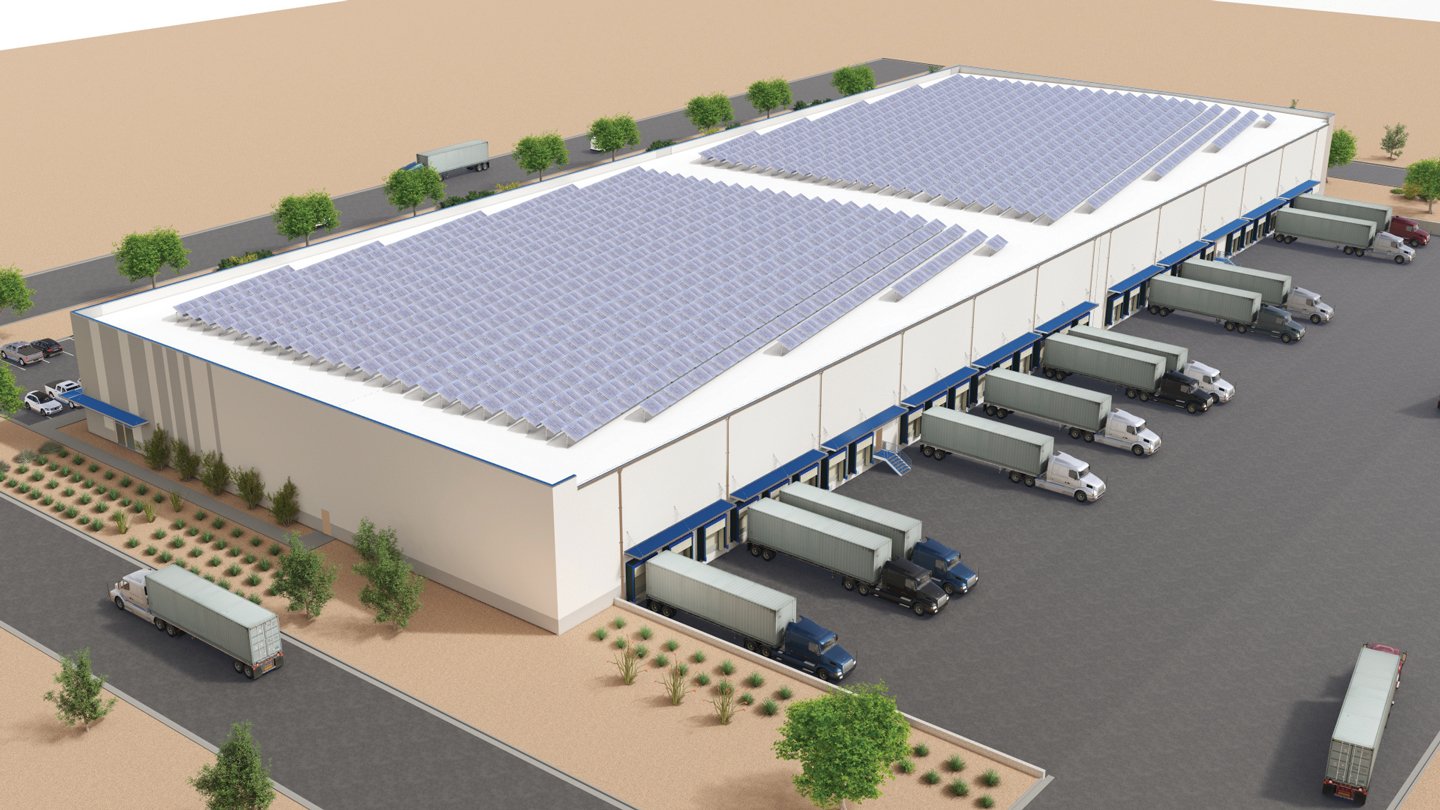Developers Can Cash Out Tax Credits for Renewable Improvements

A major change to the tax code could greatly incentivize green construction in commercial real estate.
New guidance from the Internal Revenue Service (IRS) is poised to stimulate renewable energy growth in the utility sector and invigorate investment in energy-efficient measures in commercial real estate development across the country.
In one of the most significant changes in the 150-year history of the Internal Revenue Code, renewable-energy tax credits can now be transferred tax-free to independent buyers in the for-profit sphere. They can also be directly paid out, tax-free, within the non-profit sector. These changes essentially transform renewable energy tax credits into cash, and they should evolve into a reliable financing source for commercial real estate.
While the commercial development community has welcomed the Inflation Reduction Act’s new Section 45L tax credits for energy-efficient homes and the strong write-offs available for energy-efficient commercial buildings in the Internal Revenue Code’s Section 179D, the ability to cash in federal renewable-energy tax credits is a radically different funding tool for green construction. Fiscal benefits in the form of transfers or direct payments have been available in a few states for several years, which has provided financial incentives regardless of the participants’ tax obligations. But without sufficient tax liability, traditional tax credits would expire, eliminating their economic advantage.
Integrating monetization features into renewable-energy tax credits could produce greater incentives to build more solar, wind, hydrogen, nuclear and other forms of renewable energy. In the commercial real estate sector, it is expected to drive greater adoption of solar power.
ITC and PTC
Monetizable federal tax credits fall into two categories — the investment tax credit (ITC) and the production tax credit (PTC). Taxpayers must choose one or the other; they can’t claim both. The ITC is generally 30% of the cost of the renewable-energy project and applies to the year in which the project goes into service.
The PTC is tied to the renewable energy produced by a project that has gone online within the past 10 years. Unlike ITCs, which are granted at the start of a project, PTCs are awarded incrementally over 10 years, proportional to the level of clean energy produced. PTCs are generally selected for large-scale energy production involving multi-acre solar arrays, wind turbine farms, or other clean-energy sources such as geothermal or biomass. However, in the commercial building sector, ITCs are often the preferred choice to recover 30% to 70% of renewable-energy investment costs as quickly as possible.
Consider the example of a developer building a rooftop solar array on a 100,000-square-foot office/warehouse/distribution building in New Mexico (see box at right). The anticipated costs are approximately $2,076,505 for solar photovoltaics (PV) and $1 million for an energy storage system (ESS), both of which qualify for the ITC. If the system only uses products made in the United States, the developer receives an additional 10% bonus (see box below). Therefore, 40% of the total cost of $3,076,505 for the solar and energy storage is recoverable as transferable ITCs — a total tax credit amount of $1,230,602. The developer could use these ITCs against their federal tax liability or transfer them, tax-free, to another taxpayer.
The example above also benefits from depreciation. While non-transferable, depreciation boosts the building’s economic recovery by $516,853. When added to the ITC, it yields a recovery of $1,747,455. Additionally, the developer would qualify for a New Mexico-specific transferable and refundable energy storage system tax credit worth 40% of the $1 million cost of the system, up to a limit of $150,000. The addition of this state tax credit increases the total tax credit and depreciation award to $1,897,455, which is roughly 62% of the overall system cost of $3,076,505.
More on BonusesTax credit bonuses can boost the investment tax credit’s base rate of 30%. A taxpayer can earn a 10% tax credit bonus by certifying that any steel, iron or manufactured product used in the project was made in the United States. Another 10% bonus is available for projects located in energy communities. These include brownfield sites, landfills, and areas designated as federal empowerment zones or enterprise communities. Finally, a 10% to 20% bonus is available for projects in low-income communities. These are defined as areas where at least 50% of the electricity goes to households with incomes below 200% of the poverty level or 80% below the area’s median gross income. |
A New Landscape
Because these types of transferable tax credits are new, there isn’t any data available on their value. However, in June 2023, the IRS issued temporary guidance detailing plans for an online portal, which is expected to go live later this year. The platform will assign registration numbers to ITCs and PTCs, which are necessary for transferring the tax credits. Although no tax credit sales have occurred yet, prices are expected to be high.
The combination of ITCs, associated depreciation, other federal incentives, and state and local incentives will allow developers to recoup a significant percentage of the costs of their renewable energy systems. This will lead to even greater integration of green energy sources into large-scale commercial buildings. Additionally, the reduced energy costs and support for environmental, social and governance (ESG) goals that encourage sustainable building will help these buildings stand out in the market.
Ethan Epstein is a founding principal of the New Mexico Tax Credit Alliance and the United States Tax Credit Alliance. Dale Dekker, AIA, is founding principal of Dekker/Perich/Sabatini, Ltd. Adam Harper is founder, CEO and principal of OE Solar.
How the Savings Pencil OutCalculations of the savings generated by using renewable-energy tax credits to build a hypothetical 100,000-square-foot office/warehouse/distribution building (10% office, 90% warehouse/distribution) with 36-foot clear heights, concrete tilt-up exterior walls, structural steel and a joist roof system. It is built to the standards of the 2018 International Energy Conservation Code. It features a roof-mounted solar photovoltaics (PV) system (1,589 panels) and a 1.3-megawatt battery energy storage system (ESS) to recharge electric semi-tractor vehicles and reduce overall electricity demand for the building. Initial ConstructionInternal rate of return: 14% Inflation Recovery Act/Investment Tax Credit (IRA/ITC) Incentives (40%) Solar PV: $830,602 Federal Modified Accelerated Cost Recovery System (MACRS) 80% Bonus Depreciation Solar PV: $348,853 Final TallyTotal IRA/ITC/MACRS incentives: $1,747,455 Additional SavingsAnnual electricity bill savings: $193,317 |
Additional InformationFor more information on renewable energy tax credits or related topics, visit www.taxcreditalliance.com. |
California’s Title 24 Introduces New Solar Requirements for CREProvisions require photovoltaic systems and energy storage on new non-residential construction.California’s Title 24, the state’s energy code, has required solar for all low-rise multifamily projects since 2016, but new provisions have gone into effect this year, impacting any projects permitted since January 1. To help navigate the regulatory landscape and explain how solar and energy storage can benefit building owners and developers, Rachel McCafferty, director of business development for CalSolar Inc., shared her expertise during a recent NAIOP webinar on the topic. “The solar requirement has been extended to not just multifamily projects but to all commercial and industrial new construction in California,” McCafferty explained. Changes include:
Not only is solar PV required, but battery storage also will be required on all new construction, McCafferty said. She explained that the PV system requirement is calculated based on a building’s conditioned floor area and capacity factor. The capacity factor is based on building type and climate zone. So, there can be significant variability, she pointed out. The battery storage system required is based on the solar system’s size. Owners also have the option to use the Solar Access Roof Area (SARA) formula, which calculates the solar size requirement based on total square footage available on the roof multiplied by 14 watts per square foot. “We don’t see [the SARA calculation used] a lot, especially in industrial where you have a lot of roof space,” McCafferty said, adding that it's possible to take both calculations and use the smallest of the two for building permits. There are some exemptions to the code. For example, if the building’s roof area does not have 80 contiguous square feet of space, or if the calculated PV system size would be less than four kilowatts. “We’re seeing cases in the state of California, especially with industrial spec development, where it is becoming more common for jurisdictions to require builders and developers to offset a certain percentage of the building load beyond what Title 24 stipulates,” McCafferty said. The city of Fontana, California, has an ordinance that requires all buildings over 400,000 square feet to offset 100% of the building load with renewable energy — a significant requirement. The city also requires more EV charging than is currently included in the state code. “With speculative developments, that can be challenging because you don’t know who the tenant will be,” McCafferty said. However, there are some ways to do an early-stage analysis to get some idea of what the local building codes will require. With the help of energy modeling (she estimates a typical industrial warehouse uses between 2-4 kilowatt hours per square foot per year), CalSolar can determine what would be required to offset 15% of the load, or whatever is required in the jurisdiction. An upside to these sometimes-onerous requirements is the potential for monetizing the energy transition. “We hear our commercial and industrial developers and owners often ask, ‘How do I monetize this, especially when I’m not responsible for paying the utility bill — the tenant is?’” said McCafferty, adding that tenant billing is a way for building owners to reap the rewards of installing solar. “Say you have a tenant that would be paying 10 cents per kilowatt hour to the utility. As the building owner, you can offer power at 9 cents per kilowatt hour, essentially a 10% discount. You as the building owner get to take that spread — 9 cents — as additional net operating income for your development.” This can work for single-tenant or multi-tenant scenario. For multiple tenants, owners can utilize Virtual Net Metering (VNM), which allows them to install a single solar system but allocate tenant billing credit based on the consumption of each tenant meter. “This can become pretty lucrative for building owners,” McCafferty said. Brielle Scott is senior communications manager at NAIOP. |
RELATED ARTICLES YOU MAY LIKE
Facility Managers Must Prepare for an All-Electric Future
Fall 2023 Issue







